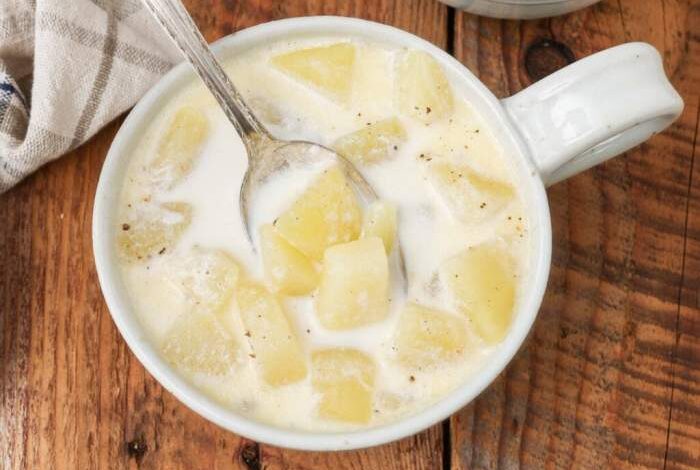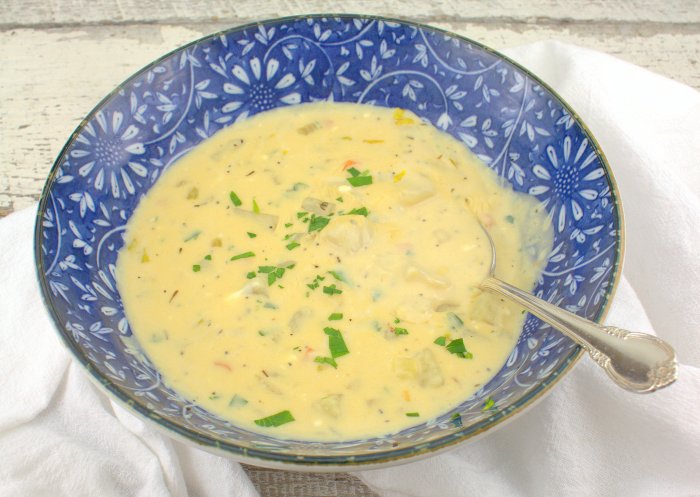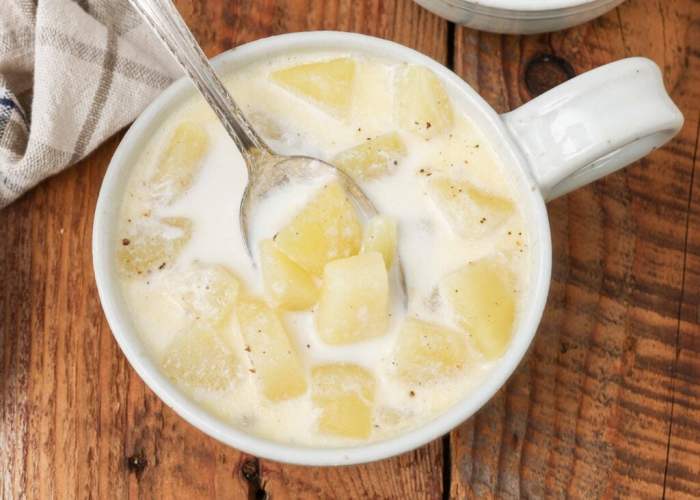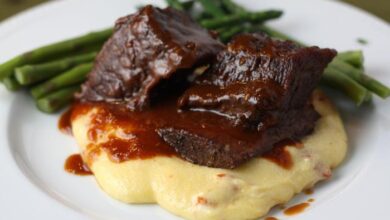
Old Fashioned Potato Soup: A Comforting Classic
Old fashioned potato soup is a timeless dish that evokes memories of cozy evenings and warm kitchens. Its simple yet satisfying flavors have been enjoyed for generations, and the recipe itself has evolved over time, incorporating regional variations and culinary innovations.
This humble soup is more than just a meal; it’s a comforting tradition that transcends cultures and connects us to the past.
From its humble origins to its modern-day interpretations, old fashioned potato soup continues to hold a special place in our hearts and stomachs. Whether you prefer a creamy, chunky, or loaded version, there’s a perfect bowl of potato soup waiting to be discovered.
History of Old Fashioned Potato Soup
Old-fashioned potato soup is a classic comfort food that has been enjoyed for generations. Its origins can be traced back to ancient times, and it has evolved over centuries to become the beloved dish we know today.
Origins and Early Recipes
Potato soup has been enjoyed for centuries, with its origins dating back to ancient civilizations. The potato, a native of the Andes Mountains in South America, was introduced to Europe by Spanish explorers in the 16th century. It quickly became a staple food, and potato soup emerged as a simple and satisfying way to utilize this versatile ingredient.
Early recipes often included ingredients like onions, butter, and milk, creating a creamy and flavorful base. These early versions of potato soup were often thickened with flour or bread crumbs, creating a hearty and satisfying meal.
Evolution of the Recipe
As potato soup evolved, it incorporated new ingredients and techniques. The addition of bacon or ham provided a savory depth of flavor. The use of herbs and spices, such as parsley, thyme, and bay leaves, added complexity and aroma.
The invention of the blender in the 20th century allowed for smoother and creamier textures.
Key Ingredients and Techniques
Despite its evolution, old-fashioned potato soup has retained certain key ingredients and techniques. The foundation of the soup is typically a combination of potatoes, onions, butter, and milk. The potatoes are usually diced or cubed, and the onions are sautéed in butter until softened.
The potatoes are then simmered in milk or broth until tender, and the soup is often thickened with flour or cornstarch.
Key Ingredients and Variations
Old-fashioned potato soup is a comforting and versatile dish that can be adapted to suit various preferences. Its core ingredients are simple and readily available, allowing for a wide range of variations.The foundation of old-fashioned potato soup is a combination of potatoes, broth, and milk or cream.
The potatoes provide the base and texture, while the broth adds flavor and moisture. Milk or cream adds richness and creaminess. Additional ingredients, such as onions, celery, carrots, and seasonings, enhance the flavor profile and complexity.
There’s something so comforting about a bowl of old fashioned potato soup, especially when it’s a chilly evening. I love the creamy texture and the hearty flavor, and I always add a dollop of sour cream and a sprinkle of chives for extra goodness.
To make it even more satisfying, I like to serve it with a side of crispy, homemade Italian sausage patties – the recipe I use is from this amazing blog – which add a savory punch to the meal. It’s a simple, yet perfect combination that always hits the spot.
Variations
The basic recipe can be expanded upon to create different variations of old-fashioned potato soup. These variations often differ in texture, flavor, and additional ingredients.
- Creamy:Creamy potato soup achieves its smooth and velvety texture by using a higher proportion of milk or cream. This variation often incorporates ingredients like butter, cheese, or sour cream to further enhance its richness.
- Chunky:Chunky potato soup retains some of the potato pieces, creating a more substantial texture. This variation often includes other vegetables, such as corn, peas, or beans, for added flavor and texture.
- Loaded:Loaded potato soup is a hearty and satisfying variation that includes various toppings, such as bacon, cheese, chives, sour cream, and croutons. These toppings add layers of flavor and texture, making it a complete meal.
Ingredient Substitutions
| Ingredient | Substitution | Effect |
|---|---|---|
| Potatoes | Sweet Potatoes | Adds sweetness and a vibrant orange color. |
| Broth | Vegetable Broth | Provides a more robust vegetable flavor. |
| Milk | Almond Milk | Offers a nutty flavor and is dairy-free. |
| Cream | Greek Yogurt | Adds tanginess and a thicker consistency. |
| Onions | Shallots | Provides a milder, sweeter flavor. |
Cooking Techniques and Methods
Making old-fashioned potato soup is a straightforward process, but mastering the technique and understanding the key considerations can elevate your soup from good to exceptional. This section delves into the steps involved in creating this classic dish, exploring different methods for thickening the soup, and highlighting important factors to consider at each stage.
Preparing the Ingredients
Before embarking on the cooking process, it is essential to gather and prepare the ingredients. Start by washing and peeling the potatoes, then cut them into uniform cubes. This ensures even cooking and a smooth texture in the final soup.
Sometimes, you crave a warm, comforting bowl of old-fashioned potato soup, but other times, you’re looking for something lighter and refreshing. For those days, I turn to a tropical mango pineapple berry smoothie , bursting with sunshine flavors. It’s a perfect way to cool down and feel energized.
But, when the weather turns chilly, there’s nothing quite like the creamy goodness of a classic potato soup to warm you from the inside out.
Similarly, prepare the onions, celery, and any other vegetables you intend to use. Chop them into small pieces to facilitate quick cooking and seamless blending with the potatoes.
Sautéing the Vegetables
Sautéing the vegetables in butter or oil before adding them to the soup adds depth of flavor and richness. Begin by melting the butter or heating the oil in a large pot over medium heat. Then, add the chopped onions, celery, and any other vegetables and cook until they soften and become fragrant, about 5-7 minutes.
Adding the Potatoes and Broth
Once the vegetables are softened, add the diced potatoes to the pot. Pour in the broth, ensuring it covers the potatoes completely. Bring the mixture to a boil, then reduce the heat to low, cover the pot, and simmer until the potatoes are tender, about 15-20 minutes.
Old fashioned potato soup is one of those comforting dishes that always hits the spot. It’s hearty, flavorful, and perfect for a chilly evening. I love how it pairs with a good, old-fashioned baked meal like als baked swiss steak , which adds a touch of savory richness to the meal.
After all, a good bowl of potato soup is a perfect way to end a delicious, home-cooked meal.
Thickening the Soup
There are various methods for thickening old-fashioned potato soup, each offering a distinct texture and flavor profile.
Using Flour
Flour is a classic thickening agent, creating a smooth and creamy consistency. To use flour, whisk together 2 tablespoons of flour with 2 tablespoons of cold water to create a slurry. Gradually whisk the slurry into the simmering soup, stirring continuously to prevent lumps from forming.
Continue to simmer for 5-7 minutes, allowing the flour to thicken the soup.
Using Cornstarch
Cornstarch provides a slightly less dense and more transparent thickening than flour. To use cornstarch, whisk together 2 tablespoons of cornstarch with 2 tablespoons of cold water to form a slurry. Gradually whisk the slurry into the simmering soup, stirring constantly to prevent lumps.
Simmer for 5-7 minutes, allowing the cornstarch to thicken the soup.
Using Milk
Milk adds a creamy richness and subtle sweetness to the soup. However, it does not thicken the soup significantly. To use milk, stir in a cup or two of milk towards the end of the cooking process, after the potatoes are tender.
This enhances the creaminess and adds a subtle milky flavor to the soup.
Blending the Soup
Once the potatoes are tender and the soup is thickened to your desired consistency, it’s time to blend it for a smooth and velvety texture. Transfer the soup in batches to a blender or use an immersion blender to puree the soup until smooth.
Seasoning and Serving, Old fashioned potato soup
After blending, season the soup with salt, pepper, and other spices to taste. You can add a pinch of nutmeg or cayenne pepper for additional flavor complexity. Serve the hot soup garnished with fresh herbs, crumbled bacon, or a dollop of sour cream.
Flavor Profiles and Enhancements

Old-fashioned potato soup, with its humble ingredients and comforting warmth, offers a canvas for a wide range of flavor profiles. From creamy and comforting to savory and spicy, the possibilities are endless, depending on the spices, herbs, and garnishes you choose to incorporate.
Flavor Profiles
The classic old-fashioned potato soup often boasts a simple, yet satisfying flavor profile, characterized by the earthy sweetness of potatoes, the savory depth of broth, and the subtle richness of milk or cream. However, you can easily tweak these base flavors to create unique and exciting variations.
Spice and Herb Enhancements
Spices and herbs play a crucial role in shaping the flavor profile of your potato soup.
- Classic Combinations:For a traditional touch, consider adding a pinch of black pepper, a bay leaf, or a sprinkle of dried thyme. These spices enhance the savory notes and add a touch of warmth.
- Spicy Kick:For those who enjoy a bit of heat, cayenne pepper, paprika, or chili powder can add a delightful kick to the soup. You can adjust the amount to your liking, starting with a small pinch and gradually increasing as desired.
- Herbaceous Depth:Fresh herbs like parsley, chives, or dill can brighten up the flavor profile and add a refreshing touch. Add them towards the end of cooking to preserve their vibrant flavors.
Garnishes and Finishing Touches
Garnishes not only enhance the visual appeal of your potato soup but also add a final layer of flavor and texture.
- Classic Choices:A sprinkle of chopped fresh parsley, a dollop of sour cream, or a few crispy croutons are classic garnishes that add a touch of elegance and complement the flavors of the soup.
- Creative Additions:For a more adventurous approach, consider topping your soup with toasted walnuts, crispy bacon bits, or a drizzle of truffle oil. These unexpected additions can elevate the flavor profile and create a truly unique experience.
- Cheese Enhancements:Shredded cheddar, Gruyere, or Parmesan cheese can add a creamy and savory dimension to the soup. Add the cheese towards the end of cooking, allowing it to melt gently into the soup.
Creating Unique Flavor Combinations
- Sweet and Savory:Combine the earthy sweetness of potatoes with the savory richness of bacon and a touch of sweetness from maple syrup or brown sugar.
- Mediterranean Inspiration:Infuse your soup with the flavors of the Mediterranean by incorporating herbs like oregano, rosemary, and thyme, along with a squeeze of lemon juice and a sprinkle of feta cheese.
- Asian Influences:For a unique twist, add ginger, garlic, soy sauce, and sesame oil to your soup. Garnish with chopped scallions and a sprinkle of sesame seeds for an authentic Asian flavor.
Achieving Desired Levels of Richness
- Creamy Texture:To achieve a luxuriously creamy texture, use full-fat milk or cream. For a lighter option, opt for low-fat milk or a combination of milk and cream.
- Thicker Consistency:If you prefer a thicker consistency, you can add a tablespoon or two of cornstarch or flour to the soup, whisking it in until it dissolves completely. You can also use mashed potatoes or potato flakes to thicken the soup.
- Flavor Depth:To enhance the flavor depth, simmer the soup for a longer period, allowing the flavors to meld and develop. You can also add a splash of white wine or a spoonful of Dijon mustard for an extra layer of complexity.
Serving Suggestions and Pairings: Old Fashioned Potato Soup
Old-fashioned potato soup is a versatile dish that can be enjoyed in a variety of ways. Its comforting flavors and creamy texture make it a perfect choice for any occasion. Here are some serving suggestions and pairings that will elevate your potato soup experience.
Serving Temperatures and Presentation Styles
Serving temperature plays a crucial role in enhancing the flavor and texture of potato soup. While it can be enjoyed hot, warm, or even cold, each temperature offers a unique experience.
- Hot:This is the classic way to serve potato soup. The hot temperature allows the flavors to fully develop and the soup to be enjoyed at its most comforting. Serve in bowls with a dollop of sour cream, chives, or bacon bits for added richness and visual appeal.
- Warm:A warm temperature is ideal for those who prefer a less intense flavor. It’s perfect for a light lunch or a cozy evening meal. Serve in mugs or bowls, garnished with fresh herbs or a sprinkle of cheese.
- Cold:While less common, cold potato soup can be a refreshing and delightful option for a summer meal. Chill the soup thoroughly and serve in chilled bowls. Garnish with chopped fresh dill or a drizzle of olive oil for a sophisticated touch.
Complementary Side Dishes and Beverages
Pairing potato soup with the right side dishes and beverages can enhance its overall dining experience. Here are some suggestions:
- Side Dishes:Grilled cheese sandwiches, crusty bread, salads, and fruit salads are excellent companions to potato soup. They provide contrasting textures and flavors, creating a well-balanced meal.
- Beverages:A glass of cold milk, iced tea, or a light beer complements the creamy texture of potato soup. For a more sophisticated pairing, consider a crisp Sauvignon Blanc or a fruity Pinot Grigio.
Occasions and Settings
Old-fashioned potato soup is suitable for a wide range of occasions and settings.
- Casual Dinners:It’s a perfect choice for a cozy weeknight meal, especially during colder months. Serve it with a simple salad or a grilled cheese sandwich for a satisfying and comforting dinner.
- Potlucks and Gatherings:Its hearty nature and ability to be made in large quantities make it ideal for potlucks and gatherings. It’s sure to be a crowd-pleaser, especially when served with crusty bread or crackers.
- Special Occasions:While it may not be the first choice for formal occasions, potato soup can be dressed up for special events. Serve it in elegant bowls with gourmet toppings like truffle oil, caviar, or roasted garlic.
Cultural Significance and Regional Variations
Potato soup, a humble yet comforting dish, transcends geographical boundaries, weaving itself into the culinary tapestry of various cultures and regions. Its simplicity and adaptability have made it a staple in countless kitchens, each region adding its own unique twist to this beloved classic.
Potato Soup in Europe
The history of potato soup in Europe is closely intertwined with the introduction of the potato itself. Brought to Europe from the Andes Mountains in the 16th century, the potato initially faced resistance, with some viewing it as a suspicious and potentially poisonous food.
However, its versatility and nutritional value eventually won over the hearts and stomachs of Europeans.
- In Germany, a hearty potato soup known as Kartoffelsuppeis often made with smoked sausage, onions, and celery. It is a popular lunch or dinner option, especially during the colder months.
- Ireland, where potatoes became a staple food, has a long tradition of potato soup. Irish potato soup often features milk, butter, and sometimes a touch of cream, creating a rich and creamy texture.
- In France, potato soup, known as soupe de pommes de terre, is often served with croutons or a dollop of crème fraîche. It can be a simple and elegant starter or a light lunch.
Potato Soup in North America
Potato soup has a special place in the culinary landscape of North America, with its origins dating back to the early days of European colonization.
- In the United States, potato soup is a ubiquitous dish, found in homes, restaurants, and even on the menus of fast-food chains. It is often served with toppings such as shredded cheese, bacon bits, or sour cream.
- Canadahas its own unique take on potato soup, with variations featuring ingredients like maple syrup, smoked salmon, or wild mushrooms.
Nutritional Value and Health Considerations

Old-fashioned potato soup is a comforting and flavorful dish that can be enjoyed by people of all ages. While it is often considered a hearty and satisfying meal, it’s important to be aware of its nutritional content and potential health implications.
Nutritional Content of Old-Fashioned Potato Soup
Potato soup is a good source of several essential nutrients, including carbohydrates, potassium, vitamin C, and fiber. However, the specific nutritional profile can vary significantly depending on the ingredients used and the cooking method.
- Carbohydrates:Potatoes are the primary source of carbohydrates in this soup, providing energy and fueling the body. However, depending on the type of potatoes used and the addition of other ingredients like milk or cream, the carbohydrate content can fluctuate.
- Potassium:Potatoes are rich in potassium, an essential mineral that plays a crucial role in maintaining fluid balance, regulating blood pressure, and supporting muscle function.
- Vitamin C:While not as abundant as in other fruits and vegetables, potatoes do contain some vitamin C, an antioxidant that supports immune function and collagen production.
- Fiber:Potatoes, particularly the skin, provide dietary fiber, which promotes digestive health, regulates blood sugar levels, and contributes to feelings of fullness.
Potential Health Benefits
- Rich in Antioxidants:Potatoes contain antioxidants, such as vitamin C and flavonoids, which help protect cells from damage caused by free radicals.
- May Support Heart Health:The potassium content in potatoes may help regulate blood pressure, which is beneficial for heart health.
- May Improve Digestive Health:The fiber in potatoes can promote regular bowel movements and contribute to a healthy digestive system.
Potential Health Risks
- High in Sodium:Many recipes for potato soup call for salt, which can contribute to high sodium intake. Excessive sodium consumption can increase blood pressure and raise the risk of heart disease.
- High in Calories:Potato soup can be high in calories, especially if made with rich ingredients like cream or butter. Frequent consumption of high-calorie soups can contribute to weight gain.
- Potential for Allergic Reactions:Some people may be allergic to potatoes or other ingredients commonly used in potato soup, such as dairy or nuts.
Creating a Healthier Version
- Use Low-Fat Ingredients:Opt for low-fat milk or cream, or use vegetable broth instead of dairy products.
- Limit Added Salt:Use herbs and spices to flavor the soup instead of relying heavily on salt.
- Include More Vegetables:Add additional vegetables, such as carrots, celery, or spinach, to increase the nutritional value and fiber content of the soup.
- Choose Whole Potatoes:Use whole potatoes, including the skin, for added fiber and nutrients.






